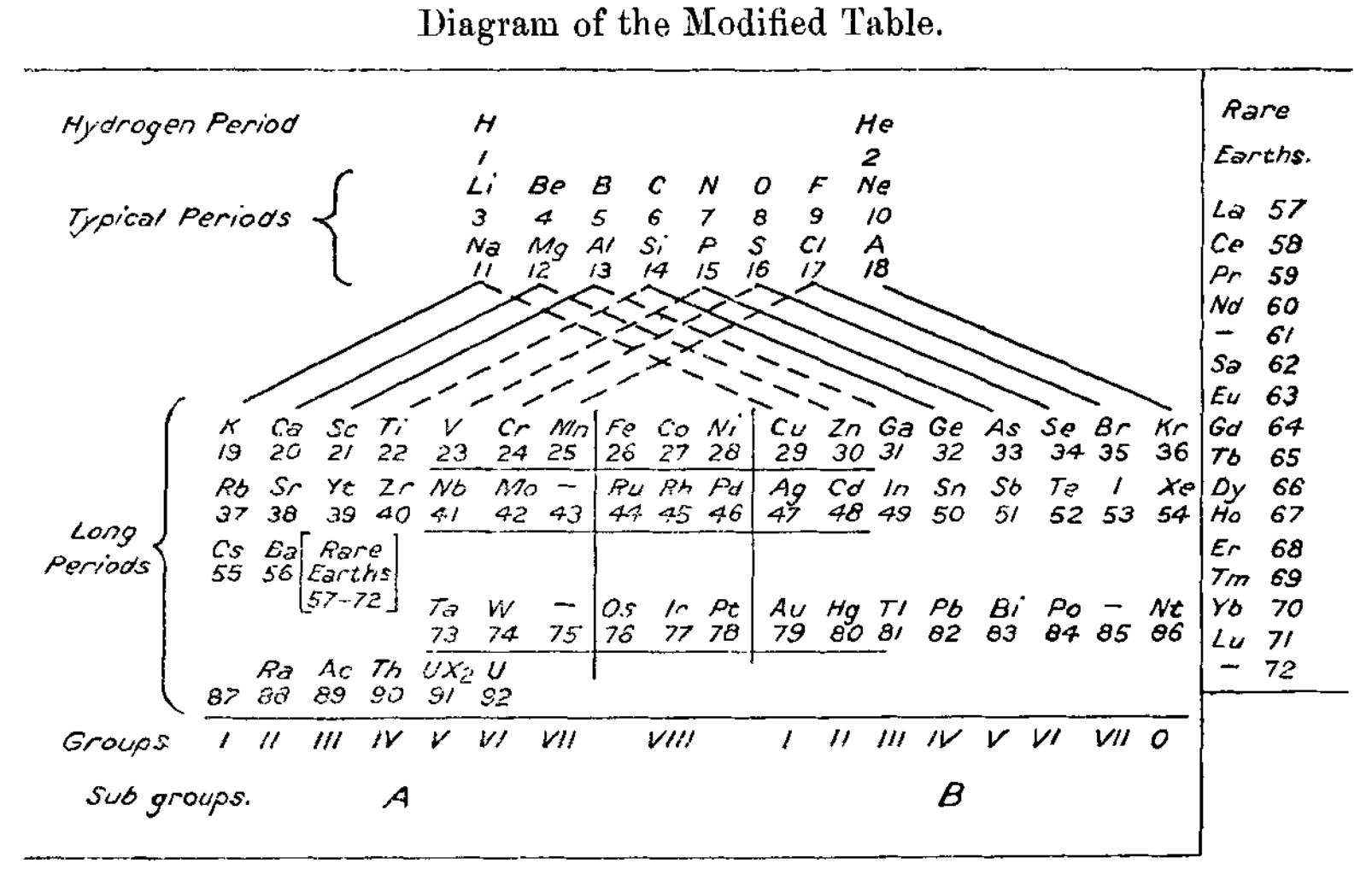Periodic Table |
 |
 |
 |
 |
 |
 |
 |
| What is the Periodic Table Showing? | Periodicity |
The INTERNET Database of Periodic Tables
There are thousands of periodic tables in web space, but this is the only comprehensive database of periodic tables & periodic system formulations. If you know of an interesting periodic table that is missing, please contact the database curator: Mark R. Leach Ph.D.
Use the drop menus below to search & select from the more than 1300 Period Tables in the database:
- SEARCH:
- By Decade
- By Type
-
Pre-Selected
Best Four Periodic Tables for Data All Periodic Tables by Name All Periodic Tables by Date All Periodic Tables by Reverse Date All Periodic Tables, as Added to the Database All Periodic Tables, reverse as Added Elements by Name Elements by Date Discovered Search for: Mendeleev/Mendeléeff Search for: Janet/Left-Step Search for: Eric Scerri Search for: Mark Leach Search for: René Vernon Search for: Electronegativity
-
By Year
2025 2024 2023 2022 2021 2020 2019 2018 2017 2016 2015 2014 2013 2012 2011 2010 2009 2008 2007 2006 2005 2004 2003 2002 2001 2000 1999 1998 1997 1996 1995 1994 1993 1992 1991 1990 1989 1988 1987 1986 1985 1984 1983 1982 1981 1980 1979 1978 1977 1976 1975 1974 1973 1972 1971 1970 1969 1968 1967 1966 1965 1964 1963 1962 1961 1960 1959 1958 1957 1956 1955 1954 1953 1952 1951 1950 1949 1948 1947 1946 1945 1944 1943 1942 1941 1940 1939 1938 1937 1936 1935 1934 1933 1932 1931 1930 1929 1928 1927 1926 1925 1924 1923 1922 1921 1920 1919 1918 1917 1916 1915 1914 1913 1912 1911 1910 1909 1908 1907 1906 1905 1904 1903 1902 1901 1900 1899 1898 1897 1896 1895 1894 1893 1892 1891 1890 1889 1888 1887 1886 1885 1884 1883 1882 1881 1880 1879 1878 1877 1876 1875 1874 1873 1872 1871 1870 1869 1868 1867 1866 1865 1864 1863 1862 1861 1860 1859 1858 1857 1856 1855 1854 1853 1852 1851 1850 1844 1843 1842 1838 1836 1831 1830 1829 1825 1824 1817 1814 1813 1811 1808 1807 1804 1803 1802 1801 1800 1798 1794 1791 1789 1787 1783 1782 1781 1778 1775 1774 1772 1771 1766 1753 1751 1748 1735 1718 1700 1690 1687 1682 1671 1669 1624 1617 1520 1000 -300 -450 -800 -1000 -2000 -3500 -3750 -5000 -6000 -7000 -9000
Periodic Tables from the year 1921:
| 1921 | Margary's Periodic Table |
| 1921 | Bury's Periodic Arrangement based on Langmuir's Theory |
| 1921 | Formánek's Periodic Table |
| 1921 | Margary's Modified Table |
| Year: 1921 | PT id = 68, Type = formulation |
Margary's Periodic Table
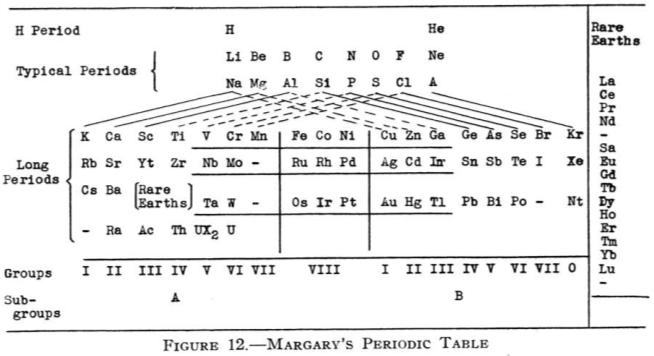
From Quam & Quam's 1934 review paper.pdf
| Year: 1921 | PT id = 1020, Type = formulation |
Bury's Periodic Arrangement based on Langmuir's Theory
Using Langmuir's theory of the arrangement of electrons in atoms, J.Am.Chem.Soc., 41, 868 (1919), Charles R. Bury formulated a Periodic Arrangement: C.R. Bury, Langmuir's theory of the arrangement of electrons in atoms and molecules, J. Am. Chem. Soc., 43, 1602-1609 (1921).
This formulation seems to be the basis of Seaborg's formulations of 1939, 1942 & 1945.
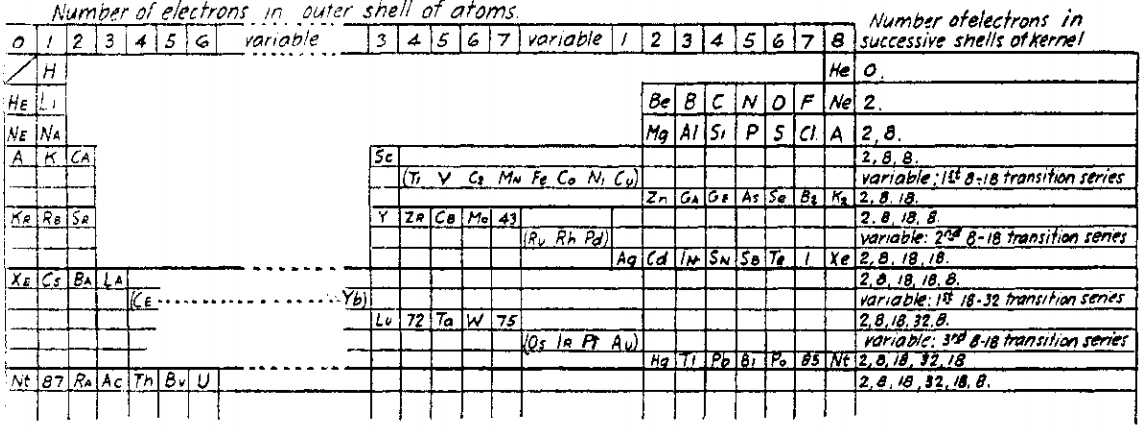
Ricardo R Contreras, Avances en Química, 14(1), 41-60 (2019), has re-drawn the Bury PT and writes [Google Translate]:
"This version emphasizes periods and electronic configurations.
"There is a long period in which the metals of titanium to copper are found, which he calls transition elements. [This formulation] leaves spaces for the element atomic number 43, technetium, discovered by Perrier Segre in 1937; for the element 72, hafnium, discovered in 1932 by D. Coster and G. von Hevesey; for the element 87, the eka-cesium, which corresponds to francium (Fr), discovered in 1939 by the French physicist Marguerite C. Perey (1909-1975) and, at the end of the group of halogens, for the element 85, the astatine (At), synthesized for the first time in 1940 by American physicists Dale R. Corson (1914-2012), Kenneth R. MacKenzie (1912-2002) and the Italian-American physicist Emilio G. Segrè (1905-1989) at the University of Berkeley (California), bombarding bismuth with particles.
"Bury uses 'A' as the symbol argon, 'Nt' (niton) for radon (Rn) and, the symbol 'Bv' (brevium) for proctactinium (Pa)."
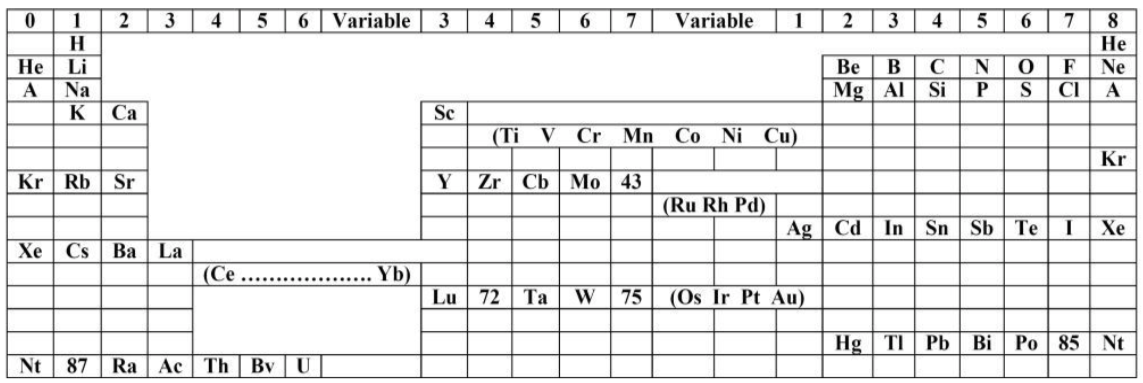
| Year: 1921 | PT id = 1192, Type = formulation |
Formánek's Periodic Table
Formánek J. 1921, Short Outline of Inorganic Chemistry (in Czech), 2nd ed., Ministerstvo zemedelstvi CSR, Praha. p. 281
René Vernon writes:
Here is an eight column table with some interesting features.
Main groups 0, Ia, IIa, Vb, VIb, and VIIb, correspond to what we have today:
- 0 Noble gases
- Ia Alkali metals
- IIa Alkaline earths
- Vb Pnictogens
- VIb Chalcogens
- VIIb Halogens
Main group IIIa is B-Al-Sc-Y... Ac whereas these days B-Al have been moved over Ga on electronic grounds. This happened despite the fact that the average trend line for chemical and physical properties v Z going down B-Al-Sc-Y... Ac is more regular.
In main group IV, notice how C and SI are positioned in the middle of the cell, unlike their neighbours to either side. The group thus bifurcates after Si into a Ti branch and a Ge branch. This is quite reasonable since there is not much difference in the average trendlines going down either option. In any case, C-Si came to be moved over Ge again on electronic grounds.
He survived the electronic revolution, staying over Ne.
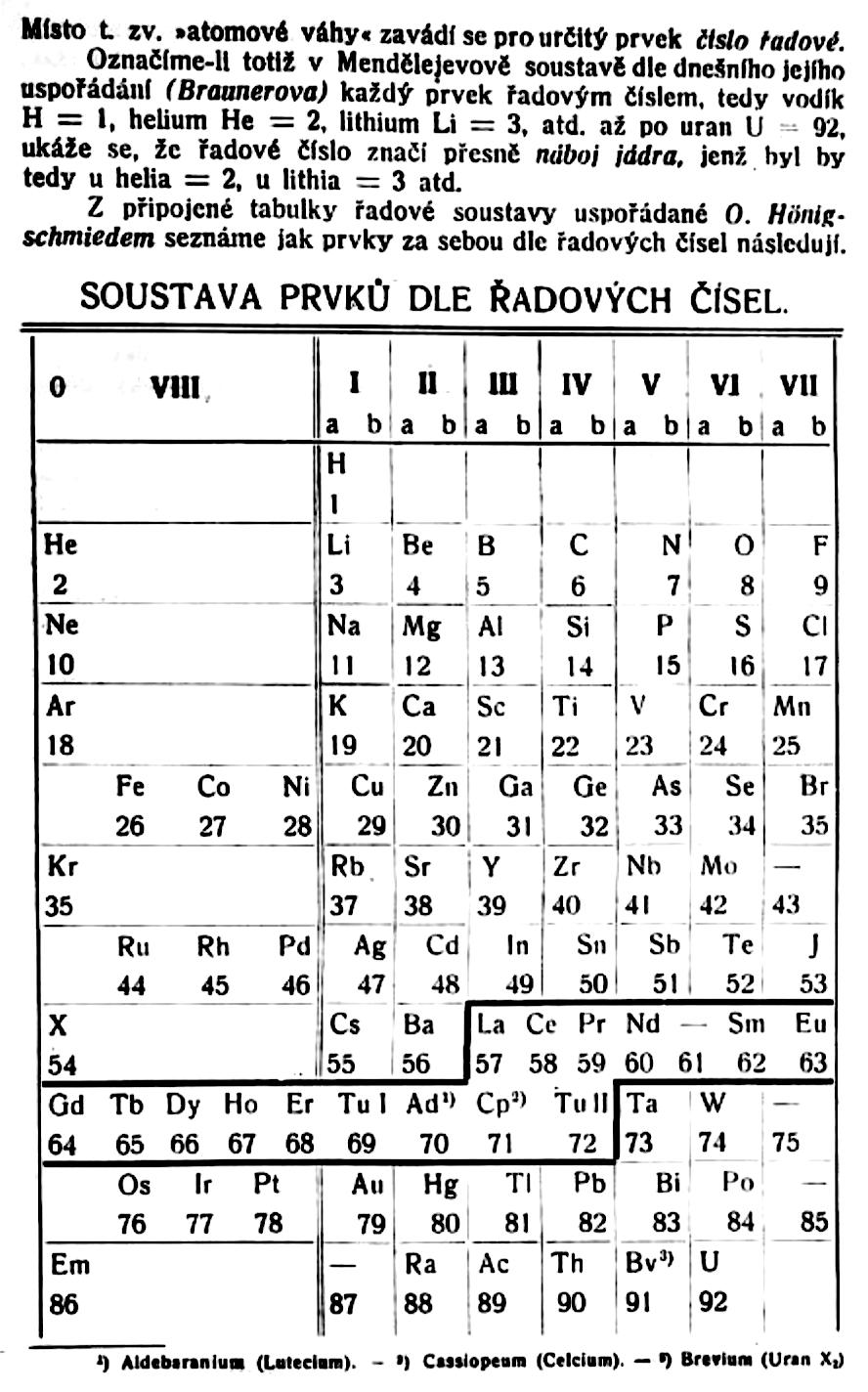
| Year: 1921 | PT id = 1237, Type = formulation |
Margary's Modified Table
Ivan D. Margary B.A. (1921) XXXVI. A modification more in accord with atomic structure, The London, Edinburgh, and Dublin Philosophical Magazine and Journal of Science, 42:248, 287-288.
An old school table showing group 3 as B-Al-Sc-Yt-Rare earths.
Thanks to René for the tip!
 |
 |
 |
| What is the Periodic Table Showing? | Periodicity |
© Mark R. Leach Ph.D. 1999 –
Queries, Suggestions, Bugs, Errors, Typos...
If you have any:
Queries
Comments
Suggestions
Suggestions for links
Bug, typo or grammatical error reports about this page,please contact Mark R. Leach, the author, using mark@meta-synthesis.com
This free, open access web book is an ongoing project and your input is appreciated.
